10 Customer Service Email Etiquette Rules You Should Know
Excellent customer service email etiquette is essential for businesses to maintain professionalism and efficiency in customer interactions, ensuring strong relationships.
Mastering customer service email etiquette transforms routine correspondence into powerful relationship-building opportunities. Proper etiquette demonstrates professionalism, reduces miscommunication, and creates lasting positive impressions that differentiate your business from competitors.
The ten fundamental rules provide a structured framework for consistent, effective communication. These guidelines ensure every team member delivers uniform service quality while maintaining your brand’s voice and values across all customer interactions.
Implementing these practices requires ongoing commitment and training, but the investment pays dividends through enhanced customer satisfaction as well as stronger brand loyalty that drives sustainable business growth.
Customer service email etiquette is the set of rules and guidelines that should be followed when communicating with customers via email. It is essential for businesses to have strong customer service email etiquette in order to provide a positive and professional experience for their customers.
Effective email etiquette directly impacts business reputation, customer retention, and brand perception. Professional communication builds trust, reduces misunderstandings, and transforms potentially negative experiences into positive ones. Hence, driving customer loyalty and word-of-mouth recommendations.
Key elements:
An average person deals with 121 business-related or marketing emails everyday. It only confirms the amount of business competition. Then, how do you stand out? Let’s explore.
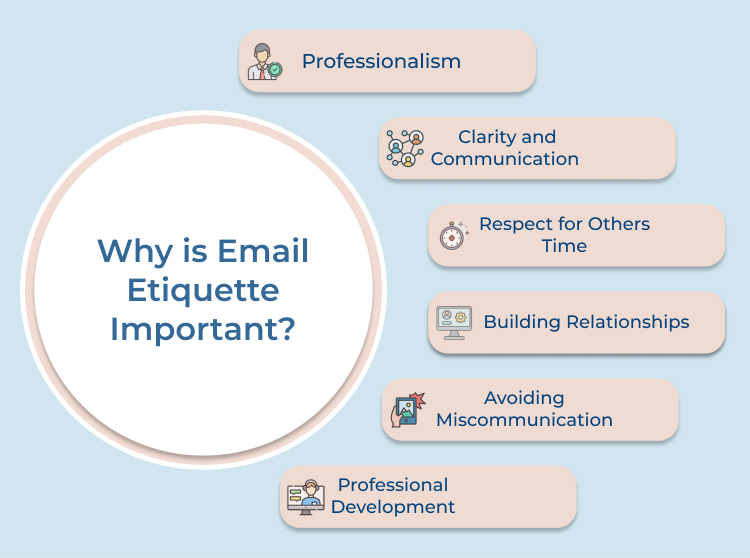
1. Professionalism: Maintaining proper email etiquette conveys professionalism and respect for the recipient. Using proper greetings, concise language and a professional tone leaves a good impression on the recipient as well as enhances your professional image.
2. Clarity and communication: Proper email etiquette ensures clear communication. Proper grammar, punctuation and formatting, conveys your message effectively while also avoiding misunderstandings. It is especially important in a professional setting where clear communication is key.
3. Respect for others time: Following email etiquette guidelines such as keeping emails brief and to the point, using subject lines effectively and responding promptly shows respect for the recipient’s time. By being considerate of the other person’s time, you are more likely to receive a timely response.
4. Building relationships: Proper email etiquette helps in building and maintaining positive relationships. Showing basic courtesy and respect in the emails demonstrates your will to build good relationships with colleagues, clients, and business contacts.
5. Avoiding miscommunication: Poorly written emails with grammatical errors, confusing language, or lack of clarity leads to miscommunication and misunderstandings. By following proper email etiquette, you minimize the risk of miscommunication and ensure that your message is understood correctly.
6. Professional development: Practicing good email etiquette also contributes to your professional development. Mastering the art of effective communication through email lets you enhance your communication skills, build quality reputation as a professional and advance in your career.
Let’s learn 10 customer service email etiquette rules that you need to follow to provide exceptional customer service.
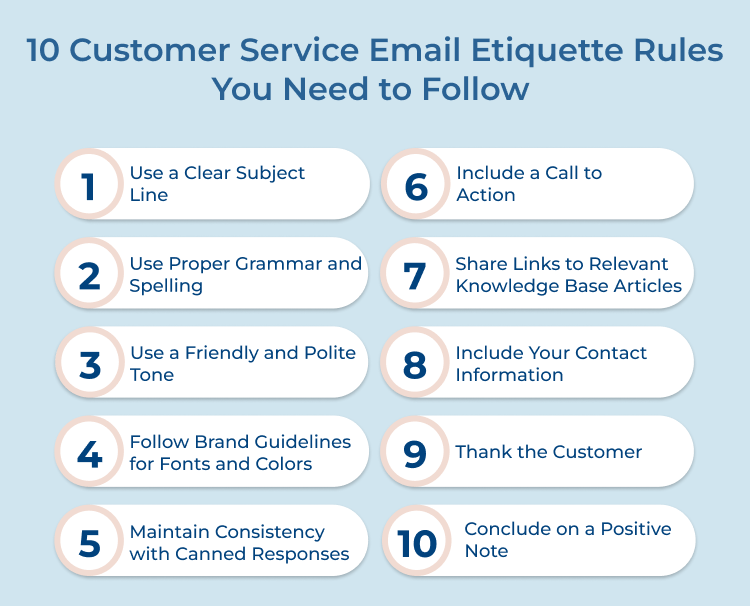
The subject line of your customer service email should be clear and concise, so the recipient knows what the email is about before opening it. A vague or misleading subject line results in confusion as well as frustration for the customer. Be specific and to the point in your subject line to set the right expectations for the email.
Nothing undermines your professionalism more than poor grammar and spelling mistakes in your customer service emails. Take the time to proofread your emails before sending them to ensure they are free of errors. Use proper punctuation and sentence structure to convey your message clearly while also being effective.
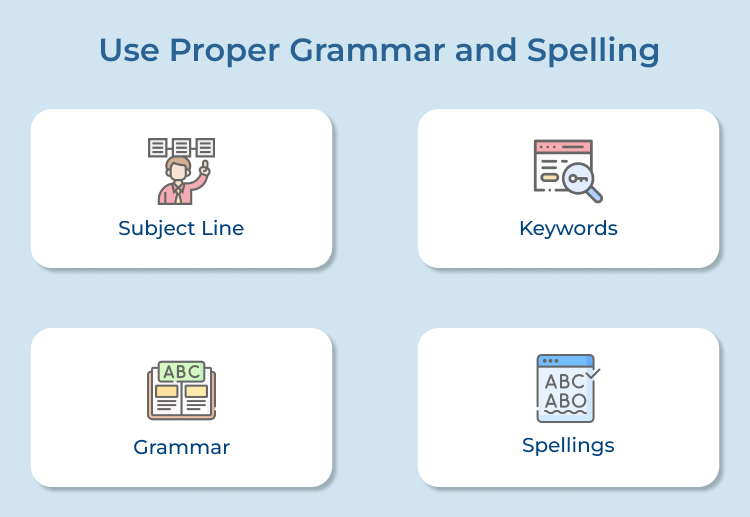
When communicating with customers through email, it’s important to maintain a friendly and polite tone. Address the customer by name, show empathy for their concerns and use positive language to provide solutions to their problems. A friendly tone builds rapport with the customer while creating a positive customer experience.
If your company has brand guidelines for fonts and colors, make sure to follow them when composing customer service emails. Consistency in branding helps reinforce your company’s image and builds brand recognition. Use the correct fonts, colors and logos in your emails to maintain a professional style along with a cohesive look.
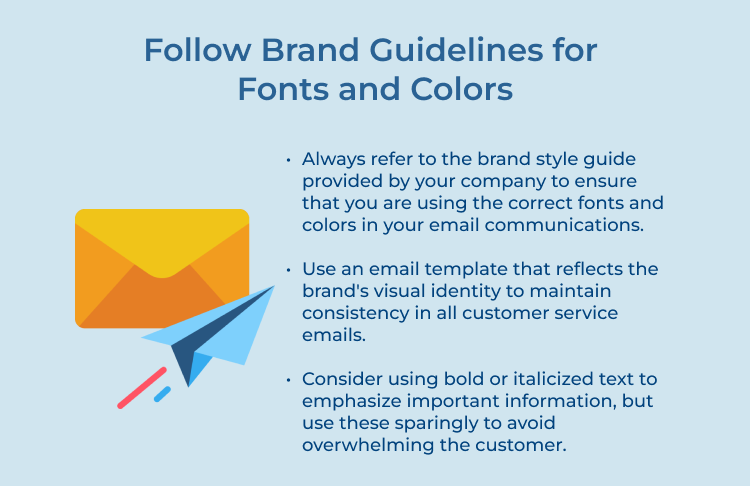
Using canned responses saves time and ensures consistency in your customer service emails. But, make sure to personalize canned responses for each customer to address their specific needs. Avoid using generic responses that don’t address the customer’s concerns, as this comes across as impersonal and insincere.
In your customer service emails, always include a clear call to action that directs the customer on what to do next. Whether it’s requesting more information, scheduling a follow-up call, or completing a survey, make sure the customer knows what steps to take after reading your email. A call to action helps drive engagement and prompt a response from the customer.
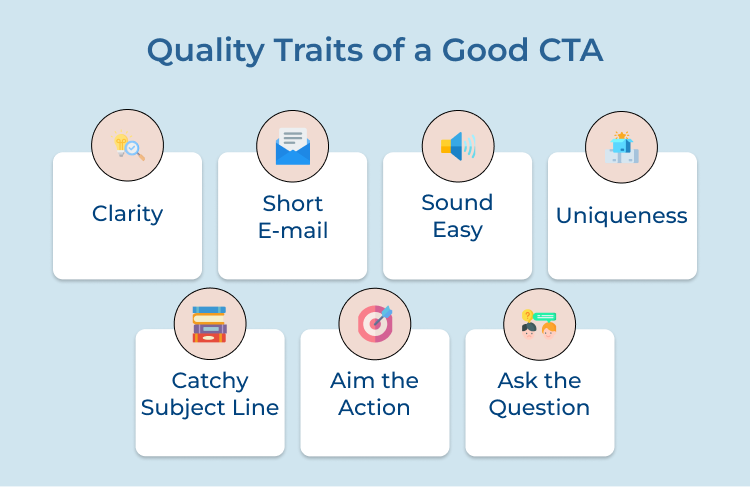
If your company has a knowledge base or FAQ section, include relevant links in your customer service emails. Providing customers with additional resources help them find answers to common questions on their own as well as reduce the need for back-and-forth communication. Share helpful articles or guides that address the customer’s concerns for a better customer experience.
Make it easy for customers to reach out to you by including your contact information in every customer service email. Provide your email address, phone number, or any other preferred contact method so the customer follows up with any additional questions or concerns. Being transparent and accessible builds credibility with the customer.
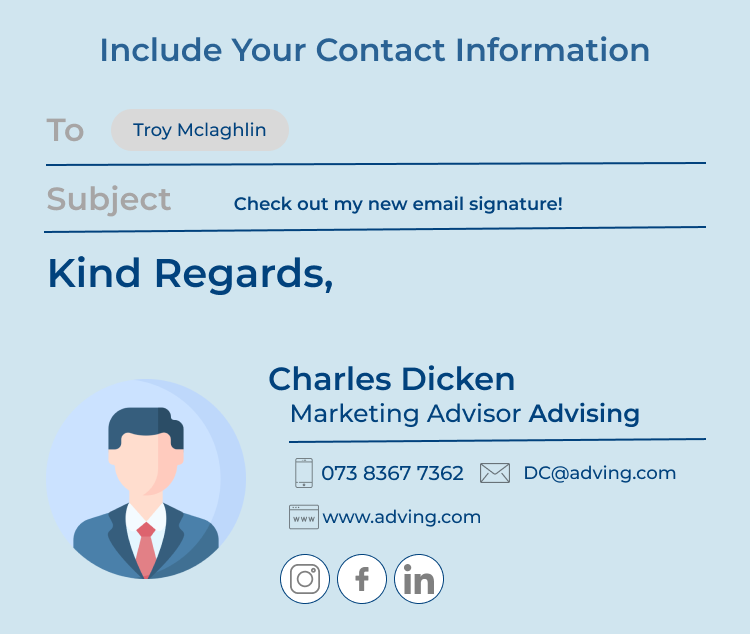
Always express gratitude to the customer for reaching out to you with their concerns or feedback. A simple “thank you for contacting us” goes a long way in showing appreciation for the customer’s time and effort. Acknowledge the customer’s communication and express your willingness to assist them in resolving their issue.
End your customer service email on a positive note by reiterating your willingness to help and reassuring the customer that their satisfaction is your top priority. Ensure your customer support emails use closing phrases such as “We look forward to assisting you further” or “Thank you for choosing us as your service provider” to leave a lasting impression on the customer. A positive conclusion leaves the customer feeling satisfied and valued.
AI technology has revolutionized the way businesses interact with their customers and email marketing is no exception.

1. Personalized Content Recommendations
AI algorithms analyze your subscriber’s behavior, interests and preferences to deliver personalized content recommendations in your emails. Segment your audience based on their emails and website interactions so as to send tailored content that resonates with each subscriber. It leads to higher engagement and conversions.
2. Predictive Analytics
AI also helps predict the best times to send emails to maximize open rates and click-through rates. By analyzing historical data and subscriber behavior patterns, AI determines the optimal times when your emails are most likely to be opened and clicked on, increasing the chances of driving conversions.
3. Automated Email Sequences
Automation tools lets you set up email sequences that trigger based on specific actions or behaviors. For example, you can send a welcome series to new subscribers, a follow-up series to prospects who have downloaded a lead magnet, or a re-engagement series to inactive subscribers. Automating these sequences nurtures your leads, builds relationships and drives sales without having to manually send emails each time.
4. Dynamic Content
Embed dynamic content in your emails, where different elements (such as images, headlines and calls-to-action) are personalized based on each subscriber’s preferences. The content increases engagement and conversions by delivering highly relevant content that resonates with each individual subscriber.
5. Email Performance Optimization
Learn the performance of your email campaigns in real-time with AI that also provide insights on what’s working and what’s not. Leverage AI to optimize your email conversations. Continually improve your email marketing strategy to drive better results and achieve your business goals more effectively.
Email is often the first line of communication between a company and its customers. But, there are some common mistakes that can easily be made when sending customer service emails.
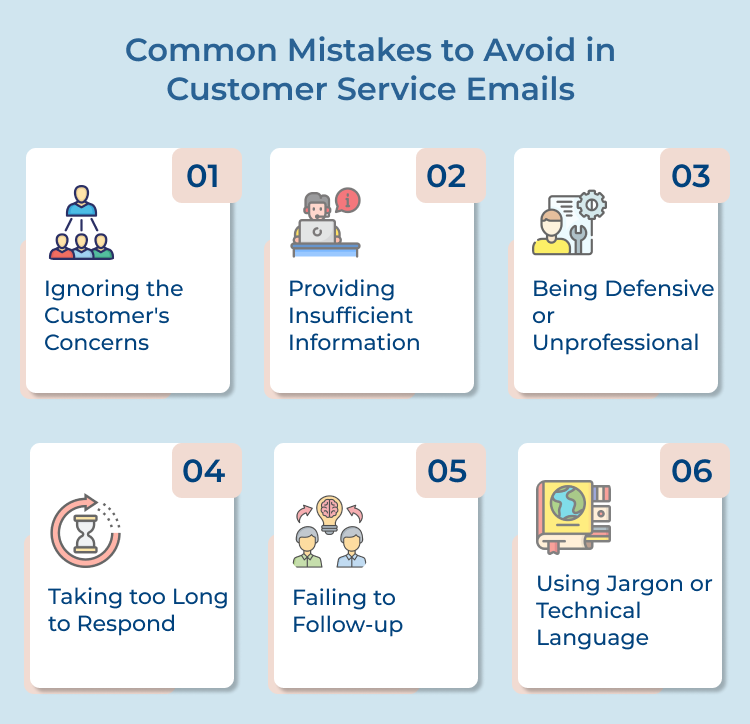
Receiving negative feedback or complaints in a customer service email can be tough, but it’s important to handle them with care and professionalism.
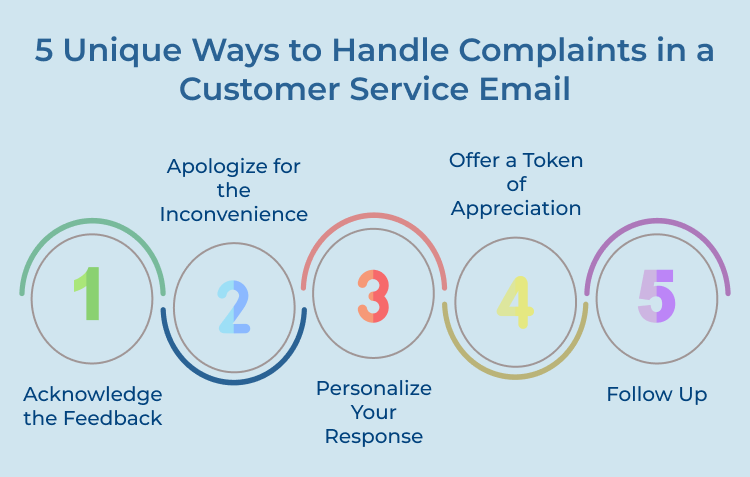
Excellent customer service email etiquette not only helps to resolve customer issues efficiently but also leaves a lasting impression on customers.
Southwest Airlines is known for its friendly customer service, both in person and online. Their email responses are warm, personalized and showcase the airline’s commitment to customer satisfaction. Southwest Airlines also provides clear instructions and support to customers facing travel-related issues.
Buffer, a social media management platform, is recognized for its transparent and proactive customer service. Their email responses are honest, informative and demonstrate a genuine desire to help customers. Buffer also values customer feedback and uses email communication as an opportunity to address customer suggestions.
Zendesk, a customer service software company, practices what they preach when it comes to customer service email etiquette. Their responses are concise, helpful and reflect a deep understanding of customer needs. Zendesk also uses automation as well as personalization to streamline their email communication process.
Warby Parker, an eyewear retailer, is praised for its friendly and efficient customer service email etiquette. Their responses are personalized, visually appealing and provide detailed information to assist customers. Warby Parker also uses humor and creativity in their emails to engage with customers while also creating a memorable experience.
Enhancing your service quality through exceptional email etiquette is crucial for building strong relationships with customers and clients. Following proper email etiquette guidelines ensure your strong intentions to have clear communication, professionalism and efficiency in all your interactions.
Remember to always address recipients respectfully, use clear & concise language and respond in a timely manner. Additionally, make sure to proofread your emails for errors before sending them out. By incorporating these practices into your daily email communication, you elevate the quality of your service and leave a positive impression on others. Start implementing these tips today and watch your service quality soar.
How can businesses maintain a consistent email tone?
Businesses maintain consistent email tone by developing a comprehensive style guide that defines their brand voice, whether professional, friendly, or conversational. Training all customer service representatives on this guide ensures uniformity across communications. Regular review sessions help identify tone inconsistencies, while templates provide structure for common scenarios. Management oversight and feedback loops reinforce adherence to established standards throughout the organization.
Is it appropriate to use automated responses in customer service emails?
While automated responses can be convenient for businesses to manage high volumes of customer inquiries, they should be used judiciously. Automated responses come off as impersonal and may not address the specific needs of the customer. It is important to tailor automated responses to the individual customer’s inquiry while ensuring that they are clear, concise and helpful.
How do you write an email to customer service?
When writing an email to customer service, it is important to be clear, concise and polite. Begin by addressing the recipient by name, if possible and clearly state the reason for your inquiry or concern. Provide any relevant details or account information to help the customer service representative assist you effectively. End the email with a polite closing and include contact information in case further communication is needed.
What is the proper etiquette for customer service?
Proper customer service etiquette involves responding promptly within 24 hours, using professional language while remaining warm and approachable. Always acknowledge the customer’s concern, provide clear solutions or next steps, and follow up when promised. Address customers by name, apologize when appropriate, and maintain confidentiality. End emails with contact information and invitation for further questions, ensuring customers feel valued throughout their experience.
What are the three 3 basic email etiquette?
The three fundamental email etiquette principles are clarity, courtesy, and professionalism. Clarity means writing concise subject lines and organizing content logically so recipients understand the message immediately. Courtesy involves using polite language, responding promptly, and showing respect for the recipient’s time. Professionalism encompasses proper grammar, appropriate tone, and maintaining boundaries while building positive relationships that reflect well on your organization’s reputation.